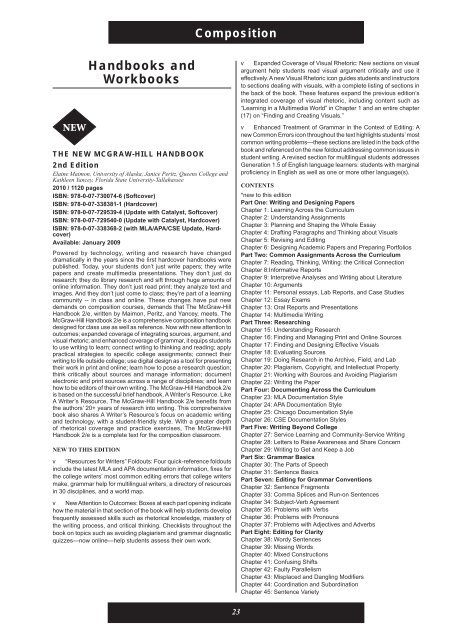ENGLISH - McGraw-Hill Books
ENGLISH - McGraw-Hill Books
ENGLISH - McGraw-Hill Books
Create successful ePaper yourself
Turn your PDF publications into a flip-book with our unique Google optimized e-Paper software.
CompositionNEWHandbooks andWorkbooksTHE NEW MCGRAW-HILL HANDBOOK2nd EditionElaine Maimon, University of Alaska, Janice Peritz, Queens College andKathleen Yancey, Florida State University-Tallahassee2010 / 1120 pagesISBN: 978-0-07-730074-6 (Softcover)ISBN: 978-0-07-338381-1 (Hardcover)ISBN: 978-0-07-729539-4 (Update with Catalyst, Softcover)ISBN: 978-0-07-729540-0 (Update with Catalyst, Hardcover)ISBN: 978-0-07-338368-2 (with MLA/APA/CSE Update, Hardcover)Available: January 2009Powered by technology, writing and research have changeddramatically in the years since the first hardcover handbooks werepublished. Today, your students don’t just write papers; they writepapers and create multimedia presentations. They don’t just doresearch; they do library research and sift through huge amounts ofonline information. They don’t just read print; they analyze text andimages. And they don’t just come to class; they’re part of a learningcommunity -- in class and online. These changes have put newdemands on composition courses, demands that The <strong>McGraw</strong>-<strong>Hill</strong>Handbook 2/e, written by Maimon, Peritz, and Yancey, meets. The<strong>McGraw</strong>-<strong>Hill</strong> Handbook 2/e is a comprehensive composition handbookdesigned for class use as well as reference. Now with new attention tooutcomes; expanded coverage of integrating sources, argument, andvisual rhetoric; and enhanced coverage of grammar, it equips studentsto use writing to learn; connect writing to thinking and reading; applypractical strategies to specific college assignments; connect theirwriting to life outside college; use digital design as a tool for presentingtheir work in print and online; learn how to pose a research question;think critically about sources and manage information; documentelectronic and print sources across a range of disciplines; and learnhow to be editors of their own writing. The <strong>McGraw</strong>-<strong>Hill</strong> Handbook 2/eis based on the successful brief handbook, A Writer’s Resource. LikeA Writer’s Resource, The <strong>McGraw</strong>-<strong>Hill</strong> Handbook 2/e benefits fromthe authors’ 20+ years of research into writing. This comprehensivebook also shares A Writer’s Resource’s focus on academic writingand technology, with a student-friendly style. With a greater depthof rhetorical coverage and practice exercises, The <strong>McGraw</strong>-<strong>Hill</strong>Handbook 2/e is a complete text for the composition classroom.NEW TO THIS EDITIONv “Resources for Writers” Foldouts: Four quick-reference foldoutsinclude the latest MLA and APA documentation information, fixes forthe college writers’ most common editing errors that college writersmake, grammar help for multilingual writers, a directory of resourcesin 30 disciplines, and a world map.v New Attention to Outcomes: Boxes at each part opening indicatehow the material in that section of the book will help students developfrequently assessed skills such as rhetorical knowledge, mastery ofthe writing process, and critical thinking. Checklists throughout thebook on topics such as avoiding plagiarism and grammar diagnosticquizzes—now online—help students assess their own work.v Expanded Coverage of Visual Rhetoric: New sections on visualargument help students read visual argument critically and use iteffectively. A new Visual Rhetoric icon guides students and instructorsto sections dealing with visuals, with a complete listing of sections inthe back of the book. These features expand the previous edition’sintegrated coverage of visual rhetoric, including content such as“Learning in a Multimedia World” in Chapter 1 and an entire chapter(17) on “Finding and Creating Visuals.”v Enhanced Treatment of Grammar in the Context of Editing: Anew Common Errors icon throughout the text highlights students’ mostcommon writing problems—these sections are listed in the back of thebook and referenced on the new foldout addressing common issues instudent writing. A revised section for multilingual students addressesGeneration 1.5 of English language learners: students with marginalproficiency in English as well as one or more other language(s).CONTENTS*new to this editionPart One: Writing and Designing PapersChapter 1: Learning Across the CurriculumChapter 2: Understanding AssignmentsChapter 3: Planning and Shaping the Whole EssayChapter 4: Drafting Paragraphs and Thinking about VisualsChapter 5: Revising and EditingChapter 6: Designing Academic Papers and Preparing PortfoliosPart Two: Common Assignments Across the CurriculumChapter 7: Reading, Thinking, Writing: the Critical ConnectionChapter 8:Informative ReportsChapter 9: Interpretive Analyses and Writing about LiteratureChapter 10: ArgumentsChapter 11: Personal essays, Lab Reports, and Case StudiesChapter 12: Essay ExamsChapter 13: Oral Reports and PresentationsChapter 14: Multimedia WritingPart Three: ResearchingChapter 15: Understanding ResearchChapter 16: Finding and Managing Print and Online SourcesChapter 17: Finding and Designing Effective VisualsChapter 18: Evaluating SourcesChapter 19: Doing Research in the Archive, Field, and LabChapter 20: Plagiarism, Copyright, and Intellectual PropertyChapter 21: Working with Sources and Avoiding PlagiarismChapter 22: Writing the PaperPart Four: Documenting Across the CurriculumChapter 23: MLA Documentation StyleChapter 24: APA Documentation StyleChapter 25: Chicago Documentation StyleChapter 26: CSE Documentation StylesPart Five: Writing Beyond CollegeChapter 27: Service Learning and Community-Service WritingChapter 28: Letters to Raise Awareness and Share ConcernChapter 29: Writing to Get and Keep a JobPart Six: Grammar BasicsChapter 30: The Parts of SpeechChapter 31: Sentence BasicsPart Seven: Editing for Grammar ConventionsChapter 32: Sentence FragmentsChapter 33: Comma Splices and Run-on SentencesChapter 34: Subject-Verb AgreementChapter 35: Problems with VerbsChapter 36: Problems with PronounsChapter 37: Problems with Adjectives and AdverbsPart Eight: Editing for ClarityChapter 38: Wordy SentencesChapter 39: Missing WordsChapter 40: Mixed ConstructionsChapter 41: Confusing ShiftsChapter 42: Faulty ParallelismChapter 43: Misplaced and Dangling ModifiersChapter 44: Coordination and SubordinationChapter 45: Sentence Variety23

















